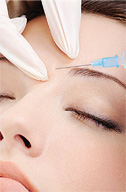 Q: I have a patient with a slightly droopy eyelid. He recently
had injections of a new botulin-based cosmetic. Could his eye problem be an
effect of the injection?
Q: I have a patient with a slightly droopy eyelid. He recently
had injections of a new botulin-based cosmetic. Could his eye problem be an
effect of the injection?
A: Could be. Cosmetic injection of botulinum toxin for frown lines between the eyebrows (glabellar lines) is usually safe, but it can occasionally cause some adverse effects, says physician assistant Monica Raymer, P.A.-C., of the Center for Facial Rejuvenation, a division of Southeast Eye Specialists, in Chattanooga, Tenn.
Specifically, the incidence of droopy eyelid (blepharoptosis) after injection of botulinum toxin type A is between 0% and 5.4%.1 Other adverse effects—headache, pain, swelling and/or mild bruising at the injection site—are typical of any injection. The new injection you describe is called Dysport (abobotulinumtoxinA, Ipsen), which was approved in April. It is indicated for cervical dystonia (involuntary spasticity of the neck muscles) and glabellar lines. The similar botulinum drug Botox (onabotulinumtoxinA, Allergan) includes those indications and is also approved for strabismus, blepharospasm and primary axillary hyperhidrosis.
However, Dysport “does tend to disperse to surrounding muscles more easily than Botox does,” Ms. Raymer says. “So, where you inject it isn’t necessarily where it stays.”
 |
| Dysport injection may be slightly more effective than
Botox—but may also have more adverse effects.
|
Though similar, Botox and Dysport are not bioequivalent, Ms. Raymer says. Dysport tends to have a slightly higher efficacy and slightly longer duration.2 Dysport can produce results in as early as one or two days, compared with three to seven days for Botox. And, Dysport’s effect can last up to a month longer than the three- to four-month effect of Botox.
But, Dysport also has a higher frequency of adverse effects.2 The reason: Dysport has different dosing units than Botox, so it is reconstituted differently. In other words, Dysport requires a different concentration of the drug per injection than Botox, so clinicians have to learn to adjust the dosage. Also, research is still emerging about the right conversion calculation between an injection of Dysport and one of Botox. And, the effect of Dysport can also depend on the patient’s muscle mass.
Still, the most recent research finds that Botox and Dysport have similar diffusion characteristics when used at comparable doses.3 In any case, “Botox is still the botulin of choice right now,” Ms. Raymer says.
How does this affect your practice? Consider: In 2008, nearly 2.5 million Americans underwent Botox procedures, which equaled $1.3 billion in revenue for Allergan. So, with such a prevalent procedure, it’s important that optometrists keep an eye on these patients and this market.
1. Gadhia K, Walmsley AD. Facial aesthetics: is botulinum toxin treatment effective and safe? A systematic review of randomised controlled trials. Br Dent J. 2009 Sep 12;207(5):E9; discussion 216-7.
2. Rosales RL, Bigalke H, Dressler D. Pharmacology of botulinum toxin: differences between type A preparations. Eur J Neurol. 2006 Feb;13 Suppl 1:2-10.
3. Pickett A. Dysport: pharmacological properties and factors that influence toxin action. Toxicon. 2009 Oct;54(5):683-9.

